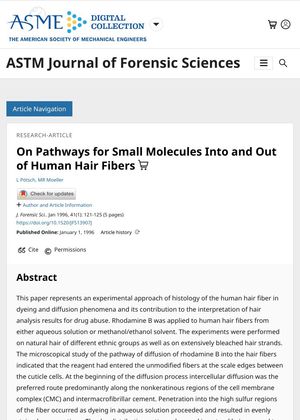On Pathways for Small Molecules Into and Out of Human Hair Fibers
January 1996
in “
Journal of Forensic Sciences
”

TLDR Dye enters hair at the edges of cuticle cells and penetrates more from water than alcohol-based solutions.
In 1996, researchers L Pötsch and MR Moeller conducted a study on the pathways for small molecules into and out of human hair fibers. They used Rhodamine B, a dye, applied to human hair fibers from either aqueous solution or methanol/ethanol solvent. The study was performed on natural hair of different ethnic groups and on extensively bleached hair strands. The microscopic study showed that the dye entered the unmodified fibers at the scale edges between the cuticle cells. The dye distribution pattern in natural hair exposed to nonaqueous solution showed that Rhodamine B did not penetrate the cortex cells as easily as from aqueous solution and selectively stained nonkeratinous regions only. The amount of dye taken up by the fibers generally increased with time and temperature and also depended on the morphology of the hair sample. The penetration of Rhodamine B from aqueous solution was much greater than from methanol/ethanol solvent.
